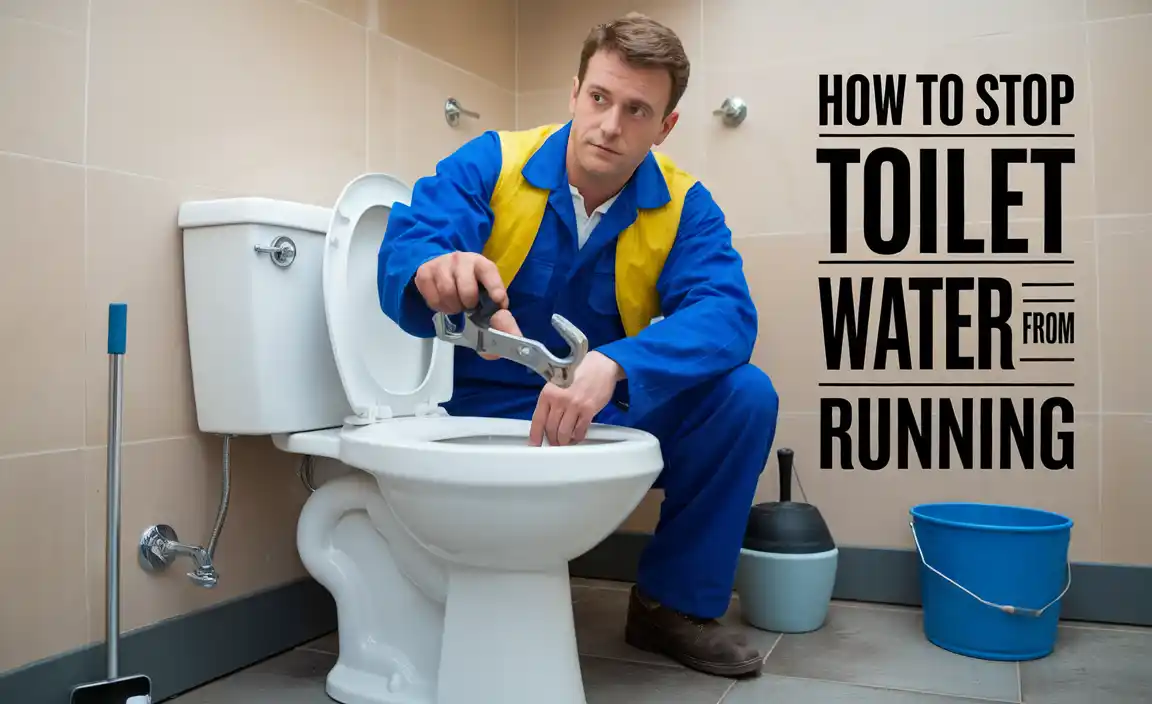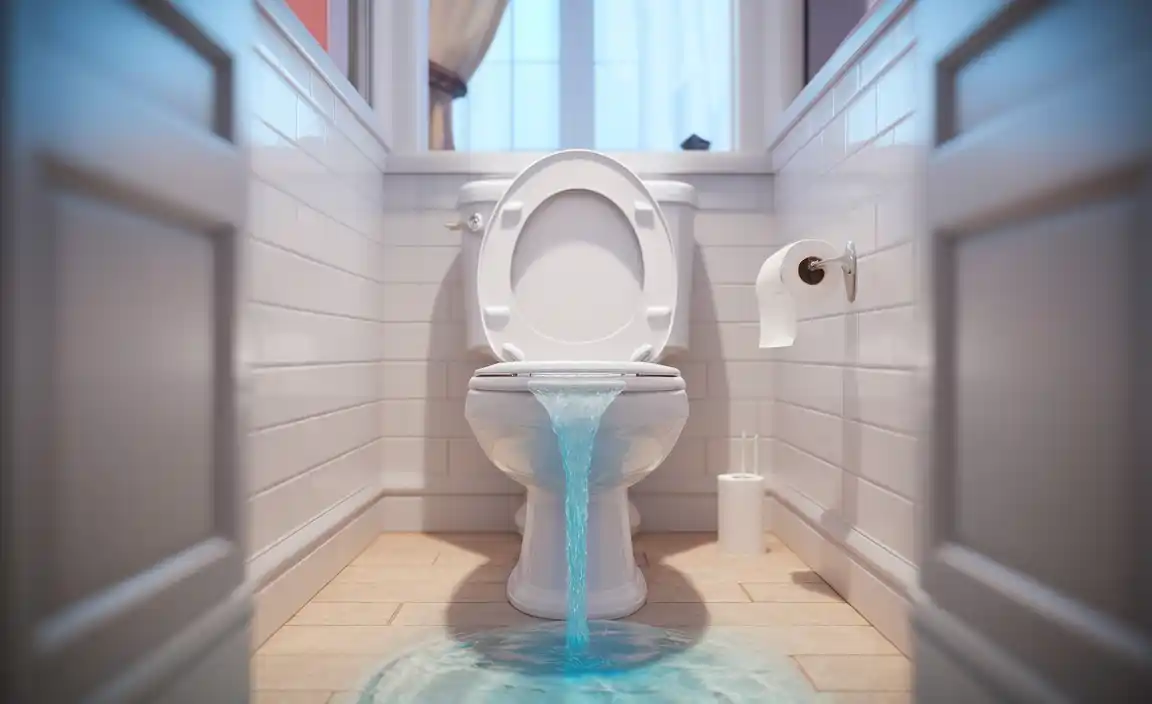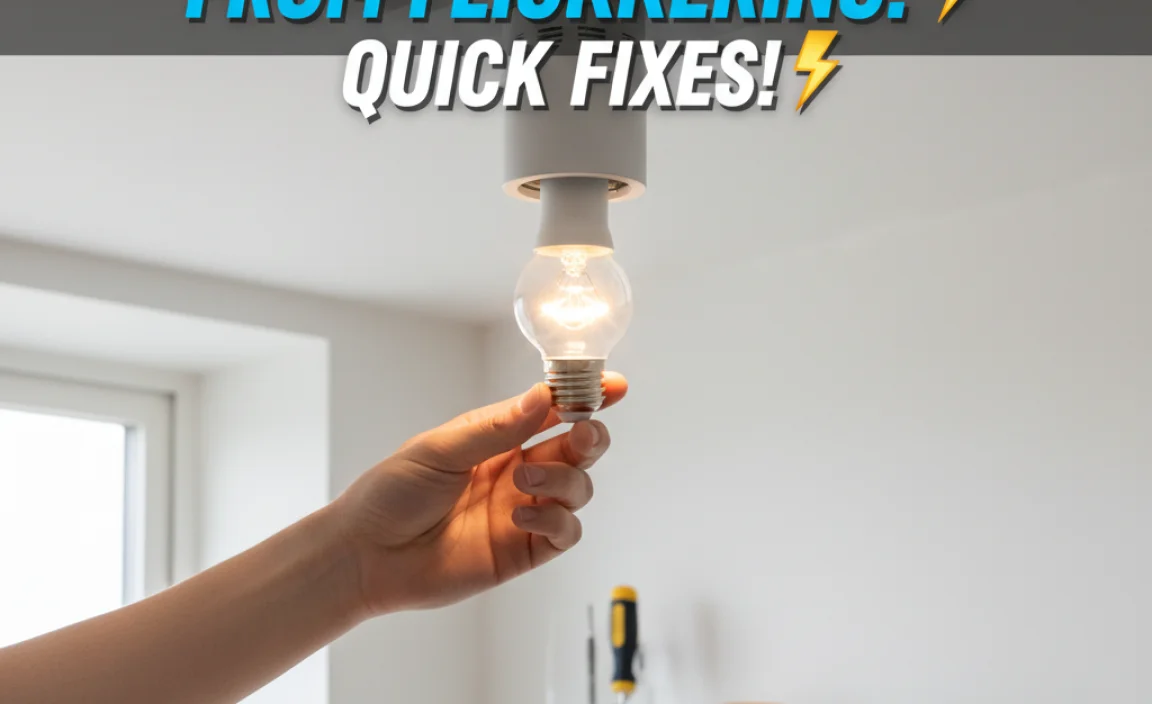
How To Stop Toilet Water From Running: Simple Fixes Explained
Toilet water running can seem like a mystery. It’s more than just annoying; it can waste a lot of water! First, check the flapper. It might need cleaning or replacing. A simple adjustment of the float arm can also fix the problem.

Sometimes, dirt or mineral buildup causes leaks. Did you know a few drops of food dye in the tank can help spot leaks? Learn these tips, and you’ll save water—and money!
Understanding the Common Causes
Flapper valve issues. Fill valve malfunctions.
Sometimes, your toilet might feel a bit chatty, running water like it’s trying to call someone! This usually happens because of two main things. First, the flapper valve can get stuck or worn out. This little guy controls the flush. If it’s not sealing right, water keeps pouring in. Secondly, the fill valve might be acting up too. If it’s broken, it won’t stop the water after a flush. Let’s break it down:
| Cause | Effect |
|---|---|
| Flapper Valve Issues | Water keeps running |
| Fill Valve Malfunctions | Water won’t stop flowing |
So, if your toilet sounds like it’s auditioning for a water park ride, it might be time for a little fix! Who knew toilets could be such drama queens?
Identifying the Problem
Inspecting for leaks. Testing the flush mechanism.
To start fixing the running toilet, look for leaks. Check under the tank and around the base. Even a small drip can waste water. Next, test the flush mechanism. Press the handle and see how it works. If it feels loose or stays down, it might need help. Understanding these issues is key to solving the problem and saving water.
How can I detect leaks in my toilet?
To find leaks, check if the water around your toilet is wet or if you hear drips. Use food coloring in the tank. If the color shows in the bowl after waiting 30 minutes, then there’s a leak. Check seals and connections.
Key Steps to Test the Flush Mechanism:
- Press the handle firmly.
- Watch how fast the tank refills.
- Listen for strange noises.
Step-by-Step Fixes
Replacing the flapper valve. Adjusting the fill valve.
To keep your toilet from sounding like a gushing fountain, start with the flapper valve. This little flap controls water flow. If it’s old and worn, it might not seal correctly. Simply replace it with a new one from the store. Next, look at the fill valve. If it’s set too high, it can cause constant running. Adjust it down a notch. Voila! Your toilet can be quieter than a ninja in slippers!
| Step | Action | Outcome |
|---|---|---|
| 1 | Replace flapper valve | Stops leaks |
| 2 | Adjust fill valve | Reduces running water |
Preventative Maintenance Tips
Regular inspections. Cleaning the toilet components.
Keeping your toilet in check can save you a lot of hassle. Regular inspections are key. Check for signs of leaks or issues once a month. It’s like a fun treasure hunt, but less exciting! Next, cleaning the toilet components helps too. Wipe down parts like the flapper and fill valve. This adds more “flow” to your throne. Clean toilets are happy toilets!
| Tip | Description |
|---|---|
| Monthly Inspections | Look for leaks or odd sounds to catch issues early. |
| Clean Components | Wipe down parts to keep them working well and avoid clogs. |
When to Call a Plumber
Complex issues beyond DIY. Signs of deeper plumbing problems.
If your toilet keeps running, it might be time to get some help. Many minor issues are fixable on your own. But what if it’s something more serious? Look for signs that say “call a plumber.” Are there strange noises, water pooling, or bad smells? These can signal deeper plumbing problems. Don’t let a small issue turn into a big mess! Here’s a quick guide:
| Signs You Need a Plumber | Possible Issue |
|---|---|
| Water pooling around the base | Leaking pipes |
| Unusual noises when flushing | Clogged or damaged parts |
| Slow draining | Blocked sewer line |
Remember, some plumbing troubles are like a mystery novel. You need a detective to solve them! If it’s beyond your skills, calling a plumber might save the day—and your bathroom!
Cost Implications of Repairs
Estimated costs for DIY fixes. Professional plumber pricing.
If toilet water keeps running, you may face costs for repairs. Doing it yourself can save money. Typical DIY fixes may cost between $10 to $50 for parts. However, hiring a professional plumber can be more expensive. Plumbers often charge around $100 to $300 for their service. Repairs might cost more depending on the issue.
How much do DIY fixes cost?
DIY fixes can range from $10 to $50. You only pay for the parts you need.
What about hiring a professional plumber?
Professional plumber fees often start at $100 and can go up to $300. This fee depends on the problem and the plumber’s rates.
Alternative Solutions
Watersaving toilet models. Utilizing tank balloons.
If you’re looking for ways to save water and stop that annoying toilet sound, consider some great options. First, think about water-saving toilet models. These toilets use less water per flush, making a big difference in your bill. Next, you can use tank balloons. These simple tools fill space in your toilet tank, so it uses less water. Together, they can be an easy fix!
What are some benefits of water-saving toilets?
Water-saving toilets can reduce your water bill and help the environment. They use less water while still flushing effectively, which is good for everyone.
Why use tank balloons?
- Tank balloons help control the amount of water used.
- They are easy to set up and affordable.
- Balloon use can cut toilet running noise.
Frequently Asked Questions
Common issues encountered. Tips for prolonging toilet lifespan.
Many people face problems with their toilet. Sometimes, water runs too long. This can waste water and money. Common issues include a faulty flapper or a broken float. These can cause the toilet to keep running. To help your toilet last, try these tips:
- Check for leaks regularly.
- Clean the tank and bowl often.
- Use a low-flow toilet to save water.
- Do not flush anything that doesn’t belong.
These simple steps can help prevent problems and extend your toilet’s life.
What are common issues that cause toilets to run?
Common issues include broken flappers and faulty floats. These parts can cause continuous running, leading to water waste.
How can I prolong my toilet’s lifespan?
To prolong your toilet’s lifespan, regular maintenance is key. This includes checking for leaks and cleaning parts regularly. A well-maintained toilet saves money and water.
Conclusion
In summary, you can stop toilet water from running by checking the flapper, adjusting the fill valve, or replacing worn parts. These simple steps can save water and money. Remember, if you’re unsure, ask a parent or guardian for help. For more tips, explore plumbing resources or watch helpful videos online. Taking action now will keep your toilet running smoothly!
FAQs
Sure! Here Are Five Related Questions On The Topic Of How To Stop Toilet Water From Running:
If your toilet water keeps running, you can try a few things. First, check the flapper. It’s a rubber part that covers the hole at the bottom of the tank. If it’s not sealing well, water keeps leaking. You can also check the float, which tells the toilet when to stop filling. If it’s set too high, adjust it or bend the arm down a little. If these tricks don’t work, ask a grown-up for help!
Sure! Just ask your question, and I will give you a simple answer.
What Are The Common Causes Of A Toilet Running Continuously?
A toilet runs continuously mostly because of three reasons. First, the flapper might be stuck or broken. This part helps stop water from flowing. Second, the float could be set too high, so it doesn’t close properly. Last, dirt or stuff might be blocking the valve, making it not work right.
How Can I Diagnose If The Flapper Valve Is The Reason For The Running Toilet?
To check if the flapper valve is causing your toilet to run, first lift the tank lid carefully. Then, look inside the tank and watch the flapper. If it doesn’t close tightly after you flush, water will keep running. You can also feel for a leak by putting a few drops of food coloring in the tank. If the color shows up in the bowl, the flapper needs fixing.
What Steps Should I Take To Fix A Toilet Float That Is Not Functioning Properly?
First, lift the lid off the toilet tank carefully. Then, check the float to make sure it moves freely. If it’s stuck, gently push it up or down. You can also adjust the float’s height using the clip or screw. Finally, flush the toilet to see if it works better now.
When Should I Consider Replacing The Entire Fill Valve Instead Of Just Repairing It?
You should think about replacing the whole fill valve if it’s very old or broken in many places. If you keep fixing it but it still leaks or doesn’t work, a new one is better. Also, if you notice rust or damage that can’t be fixed, it’s time to get a new valve. It’s simpler and can save you money in the long run.
Are There Any Temporary Solutions To Stop Toilet Water From Running While Waiting For A Repair?
Yes, there are some easy solutions to stop toilet water from running. First, you can lift the tank lid and wiggle the float. This can help it stop running. You can also turn off the water supply to the toilet by turning the valve behind it. If it still runs, you can put a towel in the tank to soak up extra water.








